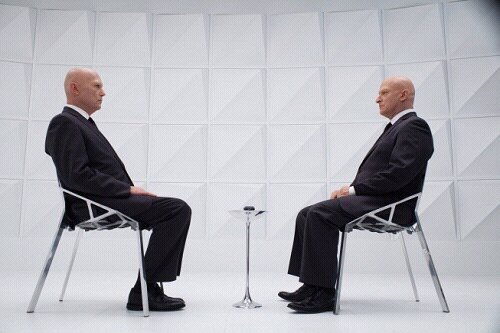[The implications of this monumental development are staggering and potentially beyond frightening. —chris]
Article HERE:
When Charles Babbage prototyped the first computing machine in the 19th century, he imagined using mechanical gears and latches to control information. ENIAC, the first modern computer developed in the 1940s, used vacuum tubes and electricity. Today, computers use transistors made from highly engineered semiconducting materials to carry out their logical operations.
And now a team of Stanford University bioengineers has taken computing beyond mechanics and electronics into the living realm of biology. In a paper to be published March 28 in Science, the team details a biological transistor made from genetic material -- DNA and RNA -- in place of gears or electrons. The team calls its biological transistor the "transcriptor."
"Transcriptors are the key component behind amplifying genetic logic -- akin to the transistor and electronics," said Jerome Bonnet, PhD, a postdoctoral scholar in bioengineering and the paper's lead author.
The creation of the transcriptor allows engineers to compute inside living cells to record, for instance, when cells have been exposed to certain external stimuli or environmental factors, or even to turn on and off cell reproduction as needed.
"Biological computers can be used to study and reprogram living systems, monitor environments and improve cellular therapeutics," said Drew Endy, PhD, assistant professor of bioengineering and the paper's senior author.
The biological computer
In electronics, a transistor controls the flow of electrons along a circuit. Similarly, in biologics, a transcriptor controls the flow of a specific protein, RNA polymerase, as it travels along a strand of DNA.
"We have repurposed a group of natural proteins, called integrases, to realize digital control over the flow of RNA polymerase along DNA, which in turn allowed us to engineer amplifying genetic logic," said Endy.
Using transcriptors, the team has created what are known in electrical engineering as logic gates that can derive true-false answers to virtually any biochemical question that might be posed within a cell. They refer to their transcriptor-based logic gates as "Boolean Integrase Logic," or "BIL gates" for short. Transcriptor-based gates alone do not constitute a computer, but they are the third and final component of a biological computer that could operate within individual living cells.
Despite their outward differences, all modern computers, from ENIAC to Apple, share three basic functions: storing, transmitting and performing logical operations on information.
Last year, Endy and his team made news in delivering the other two core components of a fully functional genetic computer. The first was a type of rewritable digital data storage within DNA. They also developed a mechanism for transmitting genetic information from cell to cell, a sort of biological Internet.
It all adds up to creating a computer inside a living cell. REST OF ARTICLE HERE
Article HERE:
When Charles Babbage prototyped the first computing machine in the 19th century, he imagined using mechanical gears and latches to control information. ENIAC, the first modern computer developed in the 1940s, used vacuum tubes and electricity. Today, computers use transistors made from highly engineered semiconducting materials to carry out their logical operations.
And now a team of Stanford University bioengineers has taken computing beyond mechanics and electronics into the living realm of biology. In a paper to be published March 28 in Science, the team details a biological transistor made from genetic material -- DNA and RNA -- in place of gears or electrons. The team calls its biological transistor the "transcriptor."
"Transcriptors are the key component behind amplifying genetic logic -- akin to the transistor and electronics," said Jerome Bonnet, PhD, a postdoctoral scholar in bioengineering and the paper's lead author.
The creation of the transcriptor allows engineers to compute inside living cells to record, for instance, when cells have been exposed to certain external stimuli or environmental factors, or even to turn on and off cell reproduction as needed.
"Biological computers can be used to study and reprogram living systems, monitor environments and improve cellular therapeutics," said Drew Endy, PhD, assistant professor of bioengineering and the paper's senior author.
The biological computer
In electronics, a transistor controls the flow of electrons along a circuit. Similarly, in biologics, a transcriptor controls the flow of a specific protein, RNA polymerase, as it travels along a strand of DNA.
"We have repurposed a group of natural proteins, called integrases, to realize digital control over the flow of RNA polymerase along DNA, which in turn allowed us to engineer amplifying genetic logic," said Endy.
Using transcriptors, the team has created what are known in electrical engineering as logic gates that can derive true-false answers to virtually any biochemical question that might be posed within a cell. They refer to their transcriptor-based logic gates as "Boolean Integrase Logic," or "BIL gates" for short. Transcriptor-based gates alone do not constitute a computer, but they are the third and final component of a biological computer that could operate within individual living cells.
Despite their outward differences, all modern computers, from ENIAC to Apple, share three basic functions: storing, transmitting and performing logical operations on information.
Last year, Endy and his team made news in delivering the other two core components of a fully functional genetic computer. The first was a type of rewritable digital data storage within DNA. They also developed a mechanism for transmitting genetic information from cell to cell, a sort of biological Internet.
It all adds up to creating a computer inside a living cell. REST OF ARTICLE HERE



